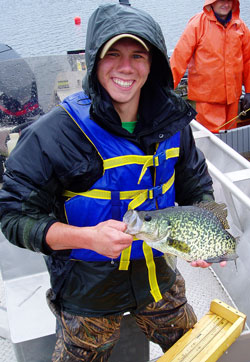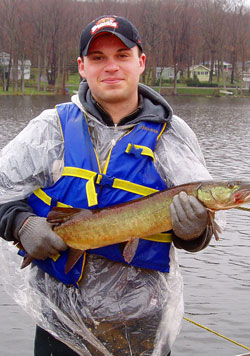|
|
Sportfishery of the smallmouth bass in Lake Erie has for years been of considerable economic value to Chautauqua County. In an effort to learn more about the population of this species in the lake and its tributaries, SUNY Fredonia Biology Professors Tim Strakosh and Ted Lee will study the genetic makeup of the smallmouth bass, beginning this summer.
“As far as we know Lake Erie has never been stocked with smallmouth bass, which means that the fishery is based upon a possibly pure, wild strain of smallmouth bass,” Dr. Strakosh said. “To help ensure a healthy fishery we need a good understanding of their population genetics.”
To that end, the scientists have received a $5,100 grant from the New York Great Lakes Protection Fund to conduct genetic analyses of smallmouth bass collected from different areas of Lake Erie. Donald Einhouse, '80, from the New York State Department of Environmental Conservation (NYS DEC) Lake Erie Unit in Dunkirk will assist with the research, along with Nicholas Sard, biology undergraduate. Mr. Sard is from Panama, N.Y., in his junior year at SUNY Fredonia.
Junior Scott Sullivan, an environmental sciences major, obtained a summer grant from the biology department to work on the project. He is from Rochester, N.Y.
Smallmouth bass spawn in both the lake and its tributaries. Previous sampling in late summer by the NYSDEC identified two different size classes of smallmouth bass fry, which has led to questions about the genetic differences between lake-spawning bass and those that spawn in tributaries.
“We want to find answers to these questions, such as do the fish spawned in tributaries make up a larger proportion of the adult population because of their early size advantage over lake-spawned fish?” Lee said. “Also, what is each tributary’s contribution to the adult population?”
The researchers will collect genetic information from both tributary and lake-spawning smallmouth bass to determine what the contribution of each is to the local adult population. Genetic variability will be assessed to identify from what population individual fish originate. These data will also directly contribute to an existing smallmouth bass genetic database.
Dr. Strakosh and his colleagues hope the grant will act as seed money for subsequent studies into the smallmouth bass population of Lake Erie.





